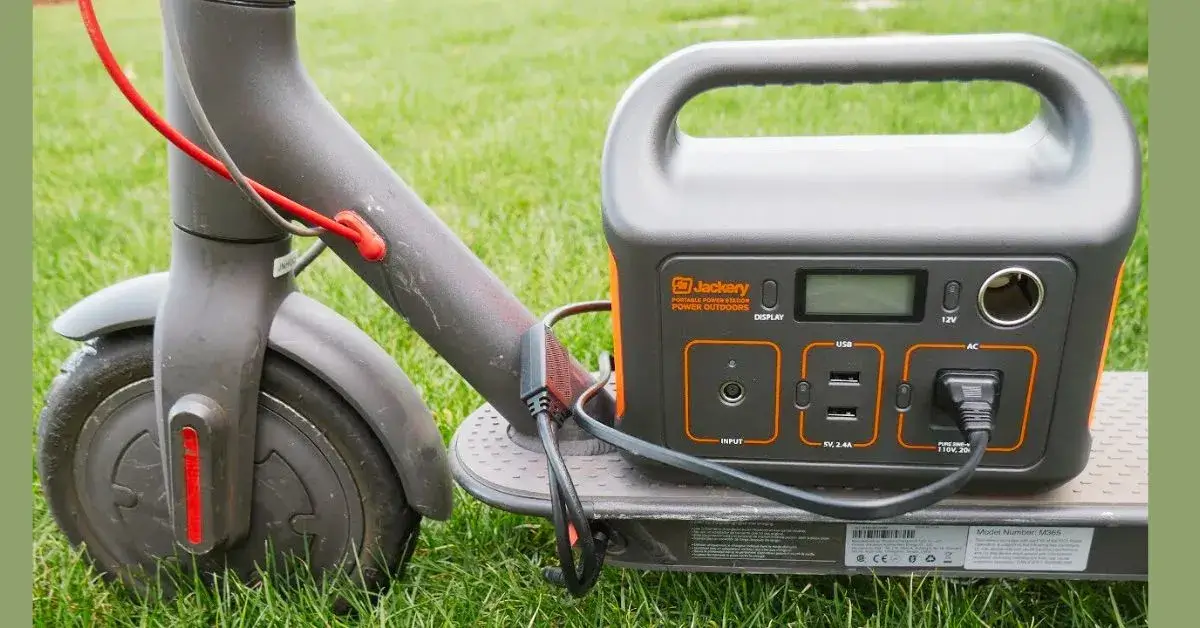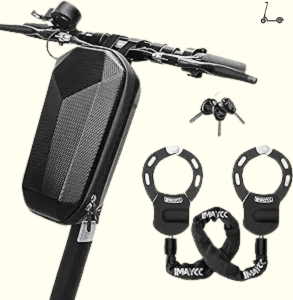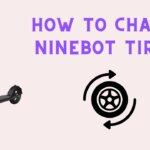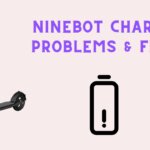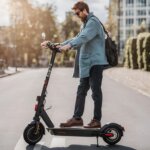In the ever-changing world of personal transportation, the electric scooter has found its place, combining sustainability and convenience. However, it can be quite frustrating when you forget or misplace the charger.
In this guide, I will explore innovative ways to keep your ride powered up, even without the standard charger. Whether you’re at work, on vacation, or facing an unexpected power outage, these tips on charging your electric scooter without a charger will ensure you’re never left stranded and always ready to roll.
Check out this All-Rounder Scooter as a Replacement!
EMOVE Cruiser S Electric scooter
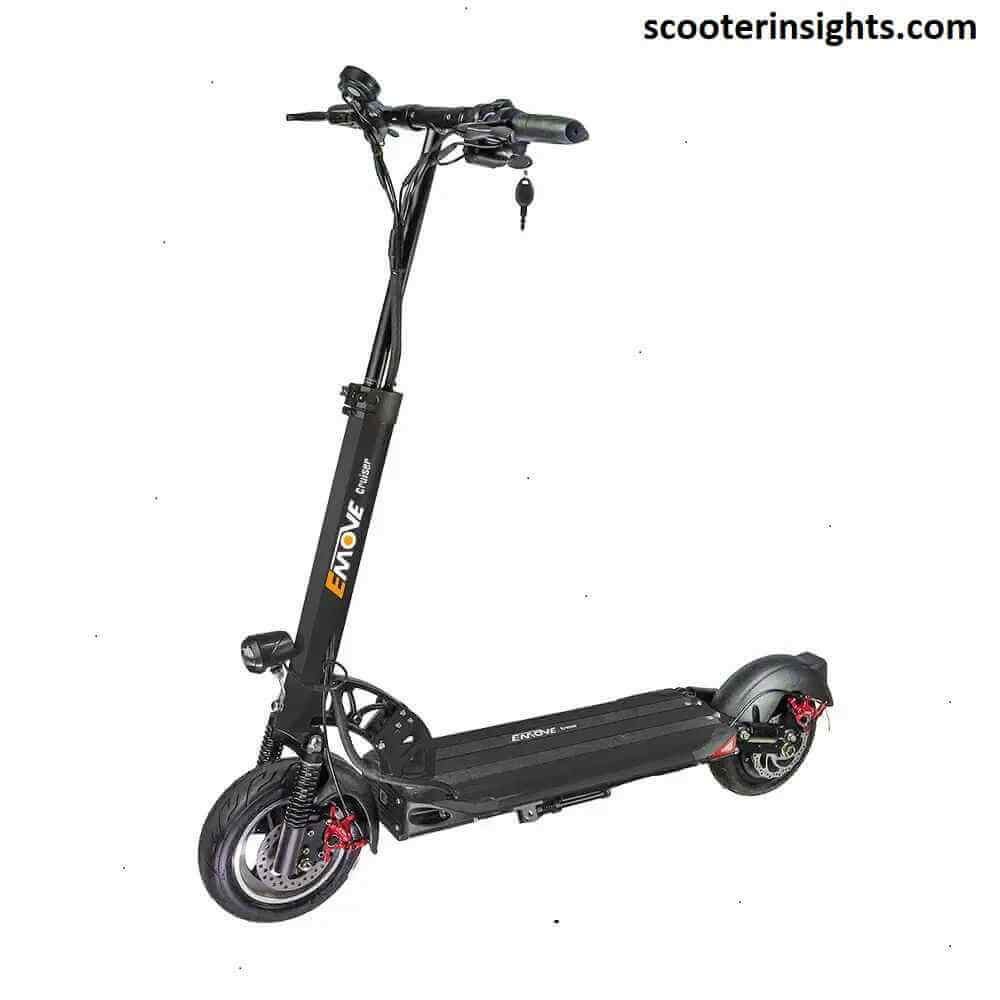
Value For Money, Affordable, Convenient & Very Customizable. Long Range & Security Concerned!
33 mph Top Speed, 62-mile Range, 56 lbs, max load 352 lbs, IPX6 Water rating, Foldable, Hybrid Hydraulic brakes, tubeless tires, LCD Display, Key Start ignition, Turn signals, Custom Throttles, Plug-and-Play cabling, 9-12 hours Charge Time.
Use Coupon Code “SCOOTERINSIGHTS” for Free DISCOUNT !!
Table of Contents
- 1 Why to Charge Electric Scooter without Charger
- 2 Method 1. Charging Electric Scooter with a Universal Charger
- 3 Method 2. Using Power Bank / Portable Charger
- 4 Method 3. Charging With Car Battery & Jumper Cables
- 5 Method 4. Using Laptop Charger (For Scooters Requiring <24V)
- 6 Method 5. Using Laptop/ Car’s Port For Charging (For Scooters Requiring 12-24V)
- 7 Method 6. Using Regenerative Braking for Charging
- 8 Method 6. Charging Scooter with Solar Power or Wind Energy
- 9 Method 7. Borrow a Charger or Visit a Service Center
- 10 Buying a Replacement Charger
- 11 Conclusion
- 12 FAQs
Why to Charge Electric Scooter without Charger
Before we dive into the different methods of charging an electric scooter without a charger, let’s understand why it is important to have alternative ways to charge your scooter.
First and foremost, forgetting or losing the charger can happen to anyone. Even if you are someone who is always organized and prepared, there could be instances when you might overlook the charger. In such cases, knowing how to charge the scooter without a charger can save you from a lot of hassle and inconvenience.
Additionally, having alternative charging methods ensures that you can use your electric scooter even in situations where there is no access to a traditional power outlet. This could be while camping, on a road trip, or during a power outage.
Moreover, using alternative charging methods can also save you money in the long run. Traditional chargers can be expensive to replace, and with alternative methods, you won’t have to worry about constantly buying new chargers.
Let’s explore some of the ways to charge an electric scooter without a charger.
Method 1. Charging Electric Scooter with a Universal Charger
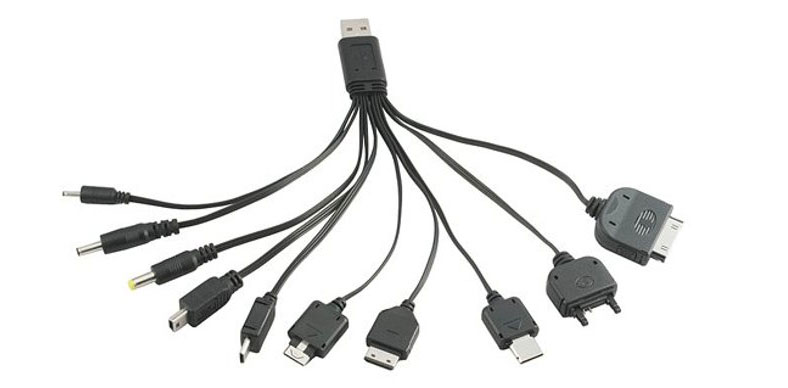
Charging your electric scooter using a universal charger can offer a flexible solution, especially in instances where your regular charger isn’t available. However, it’s crucial to understand the process and take certain precautions to ensure a safe and effective charging process.
Understanding the Specifications of a Universal Charger
Before you initiate the charging process, you need to verify the specifications of your universal charger. It’s essential for the charger to output the correct voltage required by your scooter. Always cross-reference the voltage output of the charger with your scooter’s voltage requirement to prevent any potential damage to the battery.
In cases where there’s a mismatch in voltage, consider using a voltage converter to align with your scooter’s requirements. Voltage converters can adjust the power output from the charger to match your scooter’s specific voltage needs, ensuring a safe and efficient charging process.
The Charging Proccess
Once you’ve confirmed the compatibility of your scooter and the universal charger, follow these steps:
- Plug in the Charger: First, plug the universal charger into a power outlet. Make sure the outlet is functioning correctly and can provide a steady flow of electricity.
- Connect the Charger to the E-Scooter: Next, locate the charging port on your e-scooter, which is typically located on the deck or the stem of the scooter.
- Charge the E-Scooter: With the charger plugged into both the outlet and the e-scooter, the charging process should begin. Most e-scooters and chargers have an indicator light that illuminates to show the charging status. It’s usually red during charging and turns green once the battery is fully charged.
- Unplug Once Charged: Once your e-scooter is fully charged (as indicated by the green light), unplug the charger from the e-scooter first, and then from the outlet. This order helps protect the charger and the scooter’s circuits from any potential electrical surges.
By following this guide, you can effectively use a universal charger to power up your electric scooter.
Method 2. Using Power Bank / Portable Charger
Using a portable power bank is the most convenient and efficient method to charge your e-scooter when a charger is not accessible. It offers a quick and effortless solution for powering up on the go.
Choosing The Right Power Bank
Selecting the correct power bank is crucial to ensuring a reliable charging experience. Here are the factors to consider when choosing a power bank for your e-scooter:
Capacity (mAh):
The capacity of a power bank is measured in mAh (milliampere-hours). A higher mAh rating indicates more charge cycles before the power bank needs recharging. Calculate the mAh of your e-scooter’s battery to ensure a compatible power bank capacity.
Output Power:
The output power, measured in watts, determines how quickly the power bank can charge your e-scooter. Look for a power bank with a high output power that matches the input power of your e-scooter for faster charging.
Establishing Secure Connection
If your scooter supports a compatible adapter with the portable charger, then the charging is very simple and efficient as described below in “Power Bank Adapter” method. If it does not, you can use any compatible cables to connect the scooter to the power bank’s outlet as described in the “Direct Charging Method” below. Or you can connect your battery directly to power bank.
How To Charge With Power Bank
There are several ways to charge your e-scooter with a power bank, and the method you choose may depend on your e-scooter’s design and what’s most convenient for you. Some common methods include:
Power Bank Adapter:
Some e-scooter manufacturers offer power bank adapters that allow you to plug your power bank into a specially designed port on the e-scooter. This method can be more secure and less prone to accidental disconnection.
Direct Charging:
Directly connect a power bank with the appropriate output port to your e-scooter’s charging port using a compatible cable. This method is straightforward and is the easiest to manage.
You can connect the charging cable directly to removable battery cables, or the charging ports’ pins can be connected with the positive and negative of the battery
In case of single-prong, you can remove the battery and connect it directly to scooter.
Method 3. Charging With Car Battery & Jumper Cables
Understanding Power Requirements and Safety
Before diving into how to physically connect your e-scooter to your car battery, it’s crucial to understand the power requirements and electrical safety. Electric scooters typically require a charging voltage of 42V or 36V or 24V depending on the model, which is significantly lower than the 12V output of a car battery.
This means that you have to connect two or more car batteries in series, or use a voltage converter to step-up the voltage supply.
How to Charge E Scooter Using Car Battery
Step 1: Gathering Necessary Equipment
You’ll need specific equipment to make this work safely and efficiently. This includes:
- Jumper cables with alligator clips
- A voltage regulator
- Safety glasses and gloves
- The charger for your e-scooter
- A multimeter to measure voltage and current flow
Step 2: Preparing the Car Battery
Ensure the car engine is off, and the battery is identified as a 12V DC battery. Connect the red and black alligator clips from the jumper cables to the positive and negative terminals of the car battery. It’s important to connect the e-scooter’s charging port to the power source properly by matching the positive and negative terminals to the correct cable. For more than 12V, connect two or more batteries.
Step 3: Using the Voltage Regulator (if not multiple batteries)
Connect the output of the jumper cables to the input of the voltage regulator, and then connect your e-scooter’s charger to the output of the regulator. The regulator’s job is to adjust the voltage levels so they’re safe for the e-scooter’s battery. Turn the regulator on, and use the multimeter to verify the voltage and current are at the appropriate levels.
Step 4: Charging Safely and Monitoring Progress
Keep an eye on the charging process, and take regular readings with the multimeter to check the charging levels. It’s essential to disconnect the system as soon as the e-scooter is charged. Overcharging can damage the battery. Always ensure everything is powered off before disconnecting any cables.
Method 4. Using Laptop Charger (For Scooters Requiring <24V)
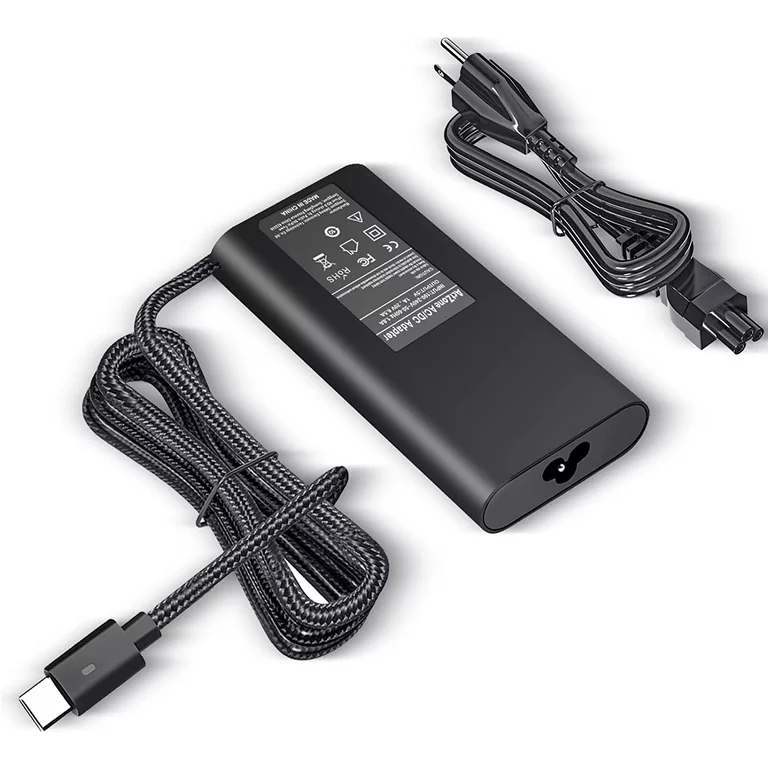
Using a laptop charger to power up your electric scooter can be an effective solution, especially when the original charger is unavailable. However, it requires careful consideration and execution to ensure safety. This guide will explain how to use a laptop charger to charge your electric scooter, step by step.
Understanding the Power Output of Your Laptop Charger
Before you attempt to use a laptop charger as a power source for your scooter, it’s essential to understand its output power. Laptop chargers typically output between 15V and 20V. To ensure a safe charging process, you need to make sure that the voltage of your laptop charger matches your scooter’s requirements.
For instance, a MacBook charger outputs either 14.5V or 20.3V, making it suitable for most of scooters. Always cross-check the output voltage of your laptop charger with the input voltage requirement of your scooter.
Regulating Voltage and Current
In some cases, your laptop charger may not match the precise voltage and current requirements of your scooter. In such scenarios, you’ll need to use a voltage and current regulator. This device adjusts the power outputs of various chargers to meet your scooter’s demands, ensuring a smooth and safe charging process.
The Charging Process
1. Connect the Charger: Securely connect the charging cable to the charging port of e-scooter. If it is not compatible, connect the laptop charger to your scooter battery’s positive and negative terminal cables. Be careful to avoid overstretching or bending any wires during the connection process.
2. Monitor Charging Progress: It’s crucial to monitor the battery level and charging progress when using a laptop charger. Once the battery is fully charged, promptly disconnect the charger to prevent overcharging.
3. Unplug and Safely Store: After the charging process is complete, unplug the charger from your scooter and the power source. Store the charger in a dry and safe location, away from any potential hazards.
By following these steps, you can effectively use a laptop charger to power up your electric scooter. However, keep in mind that this is a temporary solution.
Method 5. Using Laptop/ Car’s Port For Charging (For Scooters Requiring 12-24V)
The USB Cable Method
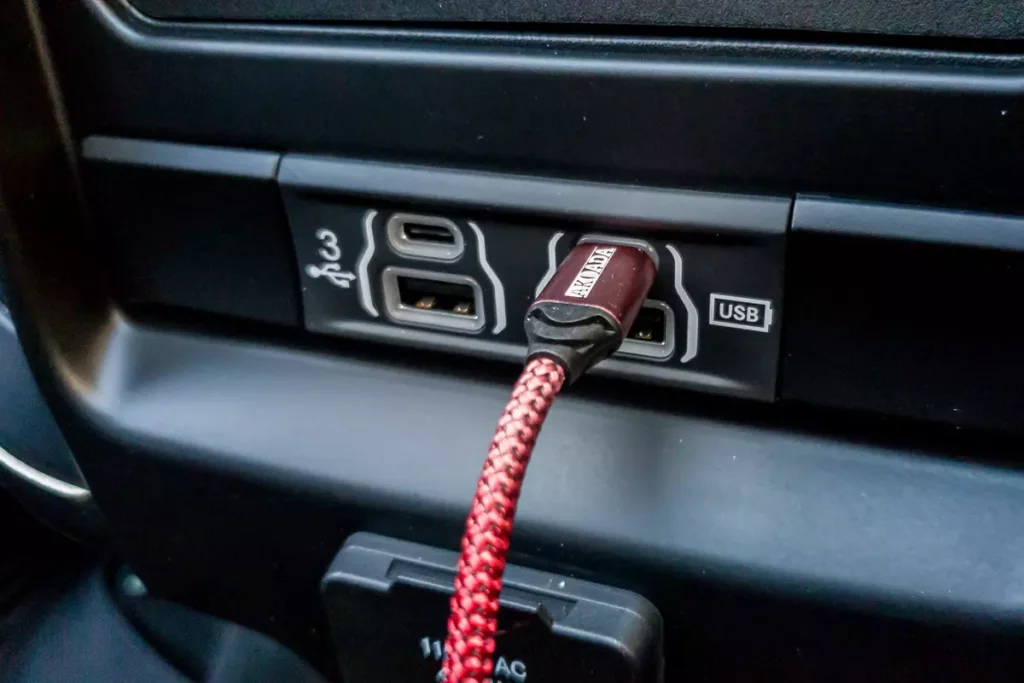
To charge your scooter properly, it’s crucial to use a USB cable that matches your scooter’s voltage and amperage needs. Not all USB cables are the same, so make sure to check the power output in volts (V) and amps (A) before connecting. Neglecting this step may result in inadequate charging or harm to your scooter’s battery.
Considering Voltage Requirements
The critical aspect to keep in mind here is the voltage output from the car’s power socket. Cars typically operate on a 12-volt system, but the power output from accessory sockets (also known as cigarette lighter sockets) can vary based on the vehicle’s model and the USB hub installed in your car.
Therefore, before proceeding with this method, it’s essential to confirm the voltage output. If you require more voltage for your e-scooter then you can connect two or more car batteries in series.
Another aspect to consider here is that many laptops provide 12V for your scooter. In such instances, if your laptop charger’s output voltage is lower than your scooter’s required input voltage, a voltage converter can step up the voltage to meet your scooter’s charging needs.
The Connection Process
Some scooters have USB charging ports, but the majority don’t have them. So, you will have to cut the other end of USB cable, get the wires out (described below) and connect them to respective prongs/pins or the battery terminals on the scooter.
Once you’ve identified a compatible USB cable, connect it to your laptop. This connection serves as the bridge between your laptop’s power supply and your scooter’s battery.
At this point, it’s crucial to understand the anatomy of a USB cable. A typical cable consists of four wires:
- Red wire: Represents positive (+)
- Black wire: Stands for negative (-)
- White and green wires: These are data wires and won’t be necessary for this charging process.
The positive and negative wires should then be connected to the appropriate pins on the scooter’s charging port or directly to the scooter’s battery terminals.
In addition to laptops, cars can also act as a handy alternative power source for charging your electric scooter. This method involves using a suitable cable to connect your scooter to the car’s power socket, similar to how you’d plug a device into a home wall outlet.
If the scooter requires more voltage than 12V, I advise to connect car batteries having more than 12V to charge the scooter, rather than the laptop.
The Importance of a Fuse (In Car Charging)
If your scooter’s charging circuit lacks a built-in fuse, incorporating an inline fuse into your charging setup is advisable. This step will safeguard your scooter’s charging circuit against potential overloads or short-circuits, which could occur due to mismatched voltages or current.
In summary, while this method requires a bit of technical know-how and careful execution, it can effectively charge your electric scooter when conventional charging options are unavailable.
Method 6. Using Regenerative Braking for Charging
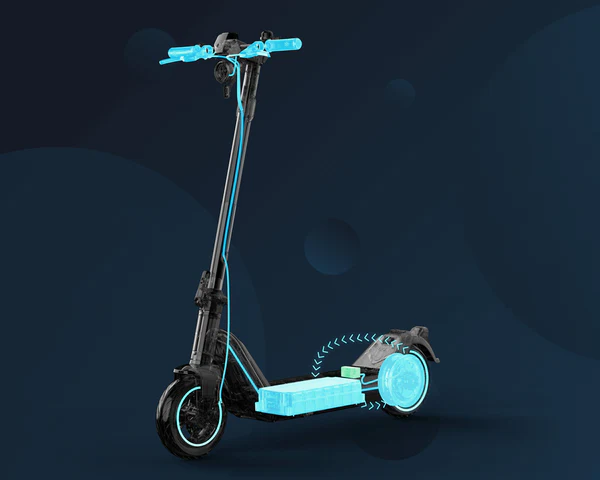
One of the most reliable ways to charge an electric scooter without a charger is by effectively utilizing regenerative braking. Nowadays, many modern e-scooters come with built-in regenerative braking technology, which can sometimes be adjusted.
Regenerative braking is a mechanism that reverses the role of an electric motor in a vehicle when it slows down, the motor acts as a generator during braking. It converts the kinetic energy of the rotating wheels into electrical energy, which is then fed back into the battery, partially recharging it.
How To Enhance Recharging By Regenerative Braking
To master regenerative braking and maximize energy recapture for scooter recharging, follow these points:.
- Practice perfect timing: Time the release of the accelerator to engage regenerative braking earlier and for a longer duration.
- Decelerate through regeneration: Allow the vehicle to slow down using regenerative braking instead of friction brakes to capture more energy. Avoid sudden stops.
- Monitor regenerative braking settings: Regularly check if adjustable and select the mode that is intense but at safe levels.
- Utilize regenerative braking to the fullest: Engage the system strategically and make the most of the scooter’s charging potential.
Method 6. Charging Scooter with Solar Power or Wind Energy
When considering sustainable energy, solar panels or wind turbines can be a clean way to charge your scooter. However, you’ll need to ensure you have the necessary equipment for energy conversion from solar or wind into usable power for your scooter.
Choose the Right Setup: Select the appropriate solar panels or wind turbines that match your scooter’s charging requirements.
Use a Converter: Convert the energy from solar or wind into the correct current (AC to DC) for your scooter. Choose a reliable converter that can handle the varying power outputs.
Establish Connection: Connect the power source to your scooter’s battery by wires/cables.
Monitor the Environment: Weather conditions directly affect solar and wind charging availability. Plan to charge your scooter when there’s ample sunlight or wind.
In addition to this, you can also buy power banks which are builted-in with compatible solar charging methods. They can charge the scooter in the same way as a regular power bank.
Method 7. Borrow a Charger or Visit a Service Center
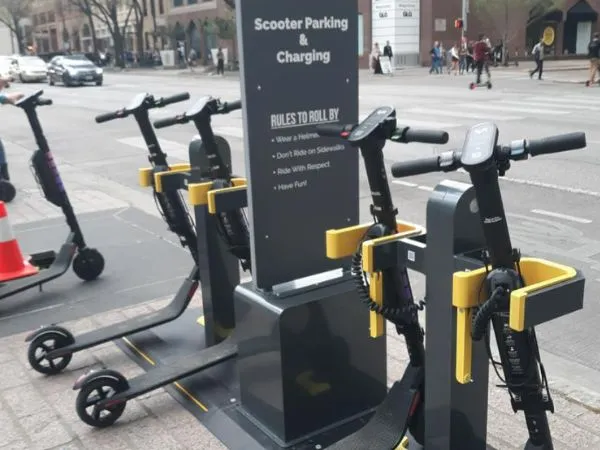
Borrowing a charger or visiting a service center can be a quick and reliable option.
Charger Checking: Before borrowing, ensure the charger is compatible with your scooter’s requirements.
Service Center Convenience: If borrowing isn’t an option, visit a service center/ Charging Center for a quick battery charge or to obtain a compatible charger.
Buying a Replacement Charger
While all of the above methods provide alternative ways to charge your scooter, investing in a replacement charger is the most convenient and effective long-term solution. This option not only guarantees compatibility but also ensures safety and convenience.
When purchasing a new charger for your electric scooter, there are important factors to consider. Follow these steps for a hassle-free shopping experience:
Know Your Specifications: Have your scooter’s voltage and prong configuration ready to find a compatible replacement charger.
Shop from Reputable Sellers: Only buy from verified sellers to ensure you receive a genuine replacement charger that meets industry standards.
Test Before You Pay: If possible, test the charger with your scooter before finalizing the purchase.
Conclusion
Navigating the challenges of charging an electric scooter without a charger requires careful consideration and knowledge of alternative methods. Whether utilizing universal chargers, power banks, or tapping into kinetic energy, this guide provides a comprehensive overview to ensure your scooter stays charged in various situations.
By understanding the specifications, prioritizing safety, and exploring innovative charging solutions, scooter owners can confidently tackle charging dilemmas, ensuring uninterrupted rides and peace of mind.
| Method | Reliability/Safety | Cost | Charging Time Efficiency |
|---|---|---|---|
| Universal Charger | High | Medium | High |
| Power Bank / Portable Charger | High | High | High |
| Car Battery & Jumper Cables | Medium | Low | Medium |
| Laptop Charger (For <24V Scooters) | Medium | Medium | Low |
| Laptop/Car’s Port (For 12-24V) | Low | Low | Low |
| Solar Power/Wind Energy | High | High | Medium |
| Service Station | Medium | Depends | High |
This table serves as a general comparison based on the information provided. Please note that the reliability/safety, cost, and charging time/efficiency may vary depending on individual circumstances and the specific implementation of each method.
I hope this guide has been helpful in providing alternative charging options for electric scooters. Let me know in the comments if you have any other methods or tips to share. Happy Scooting!
FAQs
-
How can I charge my scooter without a charger?
You can charge your scooter without a charger by utilizing alternative power sources such as a universal charger, power bank, car battery with jumper cables, or even tapping into kinetic energy with a kinetic charger or regenerative braking system.
-
What can I use to charge my electric scooter?
There are various options available to charge your electric scooter, including universal chargers, power banks, car batteries with jumper cables, solar panels, wind turbines, and kinetic chargers. Each method offers unique advantages and considerations depending on your specific needs and circumstances.
-
How do I manually charge my scooter battery?
To manually charge your scooter battery, you can directly connect it to alternative power sources such as a universal charger, power bank, or car battery using jumper cables. Ensure you follow safety precautions and verify compatibility with the scooter’s voltage and current requirements before initiating the charging process.
-
Can you charge an electric scooter with a different charger?
Yes, it’s possible to charge an electric scooter with a different charger; however, it’s crucial to ensure compatibility with the scooter’s voltage and current requirements. Using voltage regulators or converters may be necessary to align the charger’s output with the scooter’s specifications and prevent damage to the battery or charging system.
-
Can I use a laptop charger to charge my electric scooter?
Yes, you can use a laptop charger to charge your electric scooter if the output voltage and current of the charger match your scooter’s requirements. However, it’s crucial to ensure compatibility and regulate voltage and current appropriately for safe charging.
-
Is it safe to charge my electric scooter using a car battery and jumper cables?
Charging your electric scooter using a car battery and jumper cables can be done safely with the proper equipment and precautions. However, it’s essential to understand the power requirements, use appropriate voltage regulators if necessary, and monitor the charging process closely to prevent overcharging or damage to the scooter’s battery.
I’m Arsalan Ahmed, a passionate electric scooter enthusiast and the voice behind this blog. I’m here to share my expertise and insights with you. From in-depth reviews to problem-solving guides, my goal is to help you make the most of your electric scooter experience.
